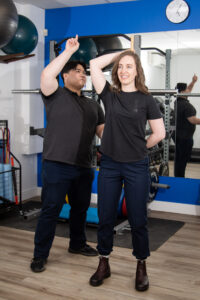Neck and shoulder pain are a common complaint we hear about from our patients. Quite often, it is caused by bad habits which have developed over time, but are hard to break out of. Our clinic physiotherapist Chris wrote a free eBook entitled ’10 Easy Ways To End Neck And Shoulder Pain’ (link below), designed to give you strategies to help resolve these issues. We have provided the first 3 tips from the guide in this blog, and if you find them helpful be sure to download your free copy of the eBook!
Watch your posture
You may not have liked to hear it when your parents told you to sit up straight when you were a kid, but we’re afraid they were telling the truth. In the absence of any specific injury, or you just felt like you woke up one day with neck or shoulder pain, this is almost the most common reason for having said pain.
Everyday in our clinic we treat patients who have not had an injury, but have neck and shoulder pain, seemingly out of the blue. With most of those patients, they have a posture where their shoulders are rolled forwards (often the side that has pain is the most rolled forwards), and/or their heads are poking out in front of them. On top of this, quite often their middle back is rounded or has a mild to moderate ‘hump’ in it. Does this sound familiar?
It’s a common problem, and you shouldn’t beat yourself up about it too much. However, it does need to be addressed or you are at risk of continuing pain and discomfort. Simply making sure that you sit/ stand up tall, with your chest out and shoulders squeezed together can go a long way, and often a person will feel improvements with just doing this. Of course, there are MANY different exercises and hands on treatments we can help guide you with in our clinic, but this is a great starting point.
We realize that sitting up straight may not feel like a natural position to be in for a lot of people, and can feel a little uncomfortable or tiring to start with, but with perseverance and guidance, improved posture is attainable and can help improve your quality of life.
Set up your computer or work desk correctly
Many of us predominantly sit throughout the day, whether its at work or at home. Not only can sitting cause you to have low back pain (see our low back pain tips guide), it can be a common cause of neck and shoulder pain too. Quite often, the reason for this is because of the way your desk is set up. Incorrect ergonomics can lead you to straining your neck and/ or shoulders, putting excessive stress on your muscles and ligaments around them. You can also end up reaching too far forwards or sideways with your hand that uses the mouse, or reaches for the phone. If you repeat these movements multiple times everyday, it can eventually lead to problems.
Here are a few simple tips you can follow to correct your desk’s set up.
- Make sure your monitor is at a good height. As you look at it, the middle of the screen should be at eye level and directly in front of you, so you are not tilting your head up, down or to the side. Your shoulders should also be relaxed and in a neutral position, and not bunched up or lifted. If your monitor is too low and doesn’t adjust, a simple fix is to get a copy of a Yellow Pages, or a couple of textbooks, and place the monitor on top of them. This can ensure you can keep your eye line in the middle of the monitor by lifting it up.
- Make sure you are holding your whole body in good posture. Make sure your hips are as far back as they can go in the chair, and ensure that your lower and middle back are supported by the back of your chair. Your shoulders should be relaxed, and your elbows, forearms and wrists should be parallel to the floor.
- Position your chair properly. If you need to, place it closer to the desk you are sitting at. This will lead to less pressure and stress on your arms, as you won’t have to place them out in front of you as much and overexert your arms, shoulders and neck. It will also prevent you from slouching forwards, which leads to neck and shoulder pain.
Get up and move
Using the above tips will greatly decrease any aches and pains that poor ergonomics can cause. However, even if you have the perfect set up, prolonged sitting in one position can cause tension on your muscles, leading to pain and fatigue. When I go and fly home to England, I feel a bit stiff and sore following the flight, just because I’ve sat down for so long. Well, most office workers are doing the equivalent of getting on a trans-Atlantic flight every day, because they simply sit down for so long and put so much pressure on their bodies by doing so.
To prevent your body from feeling like its flown to England every day for a week, we recommend the following:
- Every 20-30 minutes, stand up and have a stretch. Stand up tall and walk around for a minute or two. This will relieve the stress in your neck and shoulders, and give your muscles a break. Remember, motion is lotion and your body will feel better when you move.
- Give your eyes a break – standing up and looking away from the screen for a few seconds can re-focus and rest your eyes
- Get a standing desk. We have them in our offices at Penticton Physiotherapy & IMS Clinic, and they are a life saver (quite literally; inactivity is the 4th biggest killer worldwide annually, and is the cause of more deaths than lung cancer and HIV combined!). We like to challenge people to stand more than they sit throughout the day. For a lot of people, this is mostly limited by two factors – not having the equipment to stand at work, and psychologically readjusting to doing their work while standing. Our advice is that if you don’t ask, you don’t get; your workplace doesn’t want you to go home with aches and pains, as it will limit your productivity ,and may potentially lead them to having a WorkSafe BC Claim on their hands, so they are often quite open to the idea of modifying your workplace to include a standing desk. Also, once you get in the flow of working while standing, it becomes second nature. Give it a go!
So there we have it, 3 top tips to help begin your journey to less neck and shoulder pain. If you are interested in reading about 7 more tips you can begin using today, click here to be taken to the webpage where you can download your free copy of our eBook ’10 Easy Ways To End Neck And Shoulder Pain’!









